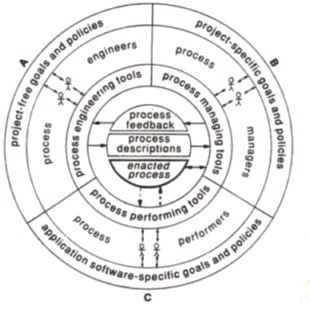 |
|
| Process Cycle |
A-B-C- D-E-F- G-H-I- J-K-L- M-N-O- P-Q-R- S-T-U- V-W-X- Y-Z
 Identification
Identification
Process Cycle
 Definitions/Uses
Definitions/Uses
| 1991 | |
|---|---|
| Reference | /Madhavji, 1991/ The process cycle |
| Definition/ Use |
The process cycle is a concise and integrated view of engineering, management, performance and improvement of software processes. The process cycle, bounded by the sectors A, B and C, defines de scope of the total set of process steps necessary for the development and evolution of software processes.
In addition, the cycle defines the key roles played by human beings, categories of tools used, goals and policies governing the processes, and inter-relationships and feedback among the different roles. The feed-front and feedback links across the three sectors complete a cycle of process engineering, management, performance and improvement: hence, the name process cycle.
Sector A: engineering process models
Sector B: managing software processes
Sector C: performing software processes |
 GDPA Online
GDPA Online
 Last Updated 01.Jan.2002 Last Updated 01.Jan.2002
 Updated by Webmaster Updated by Webmaster
 Last Revised 01.Jan.2002 Last Revised 01.Jan.2002
 Revised by Webmaster Revised by Webmaster
 |
